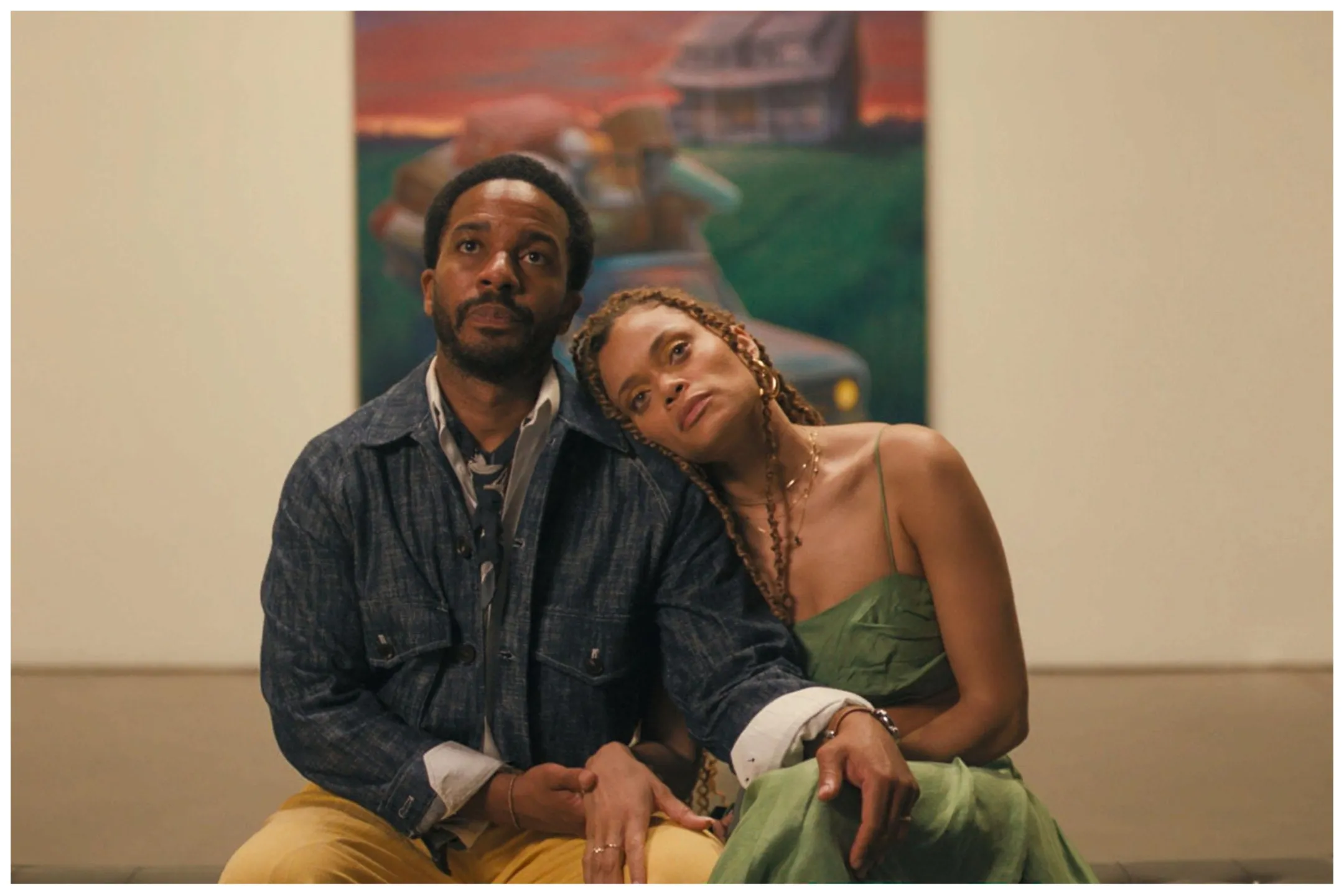Exhibiting Forgiveness
There’s a point in “Exhibiting Forgiveness”, Titus Kaphar’s exhibition that illustrates the extent to which trauma, whether racial or historical or personal, can ruin and often does destroy a person. The particular scene has few words about it being explicit; but they tell of what it means for someone to be broken. Tarrell (André Holland), an artist who paints suburban fantasies of neon light rainbows, has found his way back to La’Ron (John Earl Jelks) the father whom he had not seen for fifteen years. Now gray-haired and homeless, La’Ron is a recovering addict that was never there treating his son with ruthless disregard and violent apathy whenever he did show up. Still wanting nothing whatsoever to do with him but having decided on interviewing him on camera as regards why exactly such abuse could have come from his father towards him; thus Tarrell asks La’Ron when he had smoked crack cocaine for the first time ever in life.
La’Ron shares this story without much dramatization at face value: basically saying that while trying stop someone else who was known from lighting up pipe ,he just took one hit only himself out of curiosity or whatever made him want to do so there & then too. But afterwards reflecting upon what happened next after inhaling that drug into his system. He remembers feeling something different than anything before then so far during all previous experiences pure bliss! We always hear addicts talk about their first drink, first snort or injection etc. So broadly speaking nothing here is new. However where John Earl Jelks comes in as actor is how he delivers this recollection ;with twinkling eyes full hopefulness shining through clouds sorrow worn by many years since youth even now revealing itself more clearly.
Now here lies my rub what gets me everytime we listen to those stories told by people like him? It’s knowing very well that they are never excuses but rather confessions ;confessions from places darkest inside ourselves where light has long been forgotten so much hence cannot shine any further anymore.
There are many movies about bad fathers and their troubled sons trying to fix their relationships with them. Most of these films come from Hollywood. Almost always, the outline of these tales is the same. They share practical circumstances that throw both characters together, forcing them to deal with each other. Then they square off, barking like dogs until they admit their innermost pain, fight again and bond over the love hidden in hatred before hugging it out.
If you want to know what “Exhibiting Forgiveness” is all about, I could tell you that it fits into this model except that this movie is less melodramatic than most movies where dads reconcile with sons (and more sentimental). It’s not a feel-good movie that leaves you feeling good; it sends you out on hope instead. In its low-key mission-of-truth way, though, this film feels realer even as it scalds away at your insides with drama after quiet drama unfolding before our eyes. That is its power.
From outside looking in, Tarrell appears to be living the perfect life, nothing can take away from what he has achieved so far- or at least the film never once suggests otherwise. He lives in a city unnamed but teeming full enough for one to get lost without ever finding themselves again; every square inch designed beautifully by architects who probably made more money off this project than any other they’ve worked on combined (but we’ll never know for sure because people like Tarrell don’t keep track) anyway his house also doubles up as an art studio where he spends long hours painting canvases strewn along walls covered with posters from Spike Lee’s “Do The Right Thing”, Coppola’s “The Godfather” trilogy and Basquiat among others. The process itself may seem tedious for those unfamiliar but trust me when I say watching Tarrel working through each layer gives us insight into just how much love goes into these things it’s like Martin Scorsese did “Life Lessons” but with more color and soul. Tarrell has carved for himself a niche in the art world as that painter who nobody saw coming; you know him, he’s the one whose work is always described by critics as being “too black” (whatever that means). His wife Aisha (played by Andra Day, who also starred in “The United States vs Billie Holiday”) on the other hand is a well renowned musician which only serves to further solidify their position within this particular social stratum where they reside together along side their young son Tre (Daniel Michael Barriere) whom apart from occasional arguments over whose project gets priority next seems content with life.
But somewhere between night sweats and seizures Tarrel realizes something ain’t right though these symptoms can be attributed to stress alone as suggested by his concerned wife (Aisha), there lies within him an unrest so deep it keeps eating away at everything until all that remains is dread etched across weathered cheeks. Despite having cut off contact years ago, events begin to unravel when La’Ron enters recovery thereby rekindling certain memories especially now that momma Joyce plans on moving out of what can only be described as a haunted house. It isn’t simply anger towards how he was brought up but rather an infuriation born out of existence itself which Tarrel refuses to let go.
Titus Kaphar painter turned sculptor come installation artist (in his feature film debut), shows us just what kind of life Laron gave his son through flashbacks so vivid they’re like short stories that tattoo themselves onto your subconscious mind forever. A functional crack addict working odd jobs such as trash collector or handyman because those were only things he knew how do besides needing cash flow for drugs could easily be anyones father
We watch as he takes teenager Tarrell (Ian Foreman, in ’90s cornrows and what looks like the deepest possible gloom) on a job in his pickup truck, where they haul barrels and light fires until in a moment of purest agony Tarrell jumps from the back of the truck in a junkyard and lands with one foot square on a board with a nail in it. The pain is almost irrelevant next to La’Ron’s reaction. He doesn’t have health insurance, has no faith in white establishments, so shut up and deal with it, he tells his son. He believes that treating Tarrell with sadistic hardness will educate him and put “steel” into him (that’s also why he doesn’t bother to help). But Tarrell walks around all day on that bleeding foot; the Christly symbolism of the nail through his sole isn’t overstated it just is, showing you how everyday trauma can become personal mythology.
Can Tarrell forgive La’Ron for everything he did or didn’t do? To move forward, the movie says he must. But there’s a difference between forgiveness and touchy-feely fakery, and what moves us about “Exhibiting Forgiveness” (one of those strained bad titles, I’m afraid) is how Tarrell comes to own rather than chain his past. The climaxing sequence at Tarrell’s latest gallery opening has one false note (when he explodes at an admirer), but the small hanging sculpture he makes of La’Ron and what happens next is devastating. It gets at something about fathers many of us may feel that they were present but concealed themselves, posing their very flaws as challenges for life. Titus Kaphar created Tarrell’s art for the film; it has a tremulous glow like something haunted-house-y is inside it, just like Tarrell himself. Based on “Exhibiting Forgiveness,” it seems that, for Kaphar, filmmaking is now an extension of artistry.
Watch Exhibiting Forgiveness For Free On Gomovies.


.jpg?w=1024&resize=1024,1024&ssl=1)
.jpg?w=1024&resize=1024,1024&ssl=1)
.jpg?w=1024&resize=1024,1024&ssl=1)
.jpg?w=1024&resize=1024,1024&ssl=1)
.webp?w=1024&resize=1024,1024&ssl=1)
.jpg?w=1024&resize=1024,1024&ssl=1)
.jpg?w=1024&resize=1024,1024&ssl=1)
.jpg?w=1024&resize=1024,1024&ssl=1)